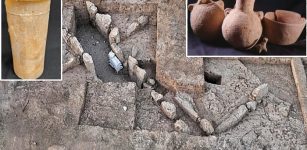Darabgerd: One Of The Oldest Cities Dated To Achaemenid Era
A. Sutherland - AncientPages.com - Remains of the ancient historical city of Darabgerd (Darabjerd) are situated six kilometers southwest of the modern town of Darab in Fars province, Iran.
Mentioned in very ancient literary works of this country, Darabgerd was one of the oldest and most prominent cities of the Achaemenid Empire.
Left: Ruins of Darabgerd, source; Right: Darius The Great, source
A legend ascribes the foundation of the city to Darius the Great (550–486 BC), the third king of the Persian Achaemenid Empire (550–330 BC).
Other medieval sources suggest that Dara, either an Achaemenid king or one of the Frataraka "maker of fire" or "keeper of fire" rulers of Arsacid Persis, could be the founder of the city.
It was even proposed that Darius III was the last Achaemenid King of Kings of Persia.
The place's earlier name was Darabgerd (Daráb-gerd (Darius-town or the land of Darius) - and now, Darab was not the only town founded by Darius I.
It might have been the first circular structure built by the third king of the Empire and is among old Persian cities having a circular plan and four gates.
The idea of planning circular cities is old and dates back to the time of the Assyrians, whose famous military camps were circular-shaped enclosures.
Position of the gates of Darabgerd, which is visible on satellite photo (adapted from the Google Earth site). source
However, in Persia, the design of round cities also has a long tradition. According to Herodotus (I. 98), Ecbatana, the Median capital in the late 8th century BC, was designed as a circular system; encircled by seven rings of walls. Since the Parthian period, several circular cities such as Hatra and Darabgerd have been noteworthy.
Darabgerd is among old Persian cities with a circular plan and four gates, but so is an ancient town in Media in western Iran – Ecbatana.
According to Herodotus, the city was chosen as the Medes' capital in the late 8th century BC by a Median king, Deioces.
The governmental citadel was located at the top of the dome-shaped mountain. A very high circular rampart and a deep trench protected the city.
Today, in the vicinity of the city, there are some remains of the citadel in the form of earthworks arranged in a circle around an isolated rock and a giant bas-relief carved on the vertical face of a stone, representing the victory of the Sasanian king Shapur I over the Roman emperor Valerian in 260 AD.
There are also three fortresses north of the Darabgerd archaeological site.
Drawing after engraving The Seven Great Monarchies Of The Ancient Eastern World, Vol 3. (7). Shapour cave is located in the Zagros Mountains in southern Iran, about 6 km from the ancient city of Bishapur. This cave is near Kazerun in Chogan valley, the site of polo/chogan in the Sasanian period. In the cave, on the fourth of five terraces, stands the colossal statue of Shapur I, the second ruler of the Sasanid Empire. The statue was carved from one stalagmite. The height of the figure is 7 m. high and its shoulders are 2 m. wide, and its hands are three m. long. source
Around this ancient city is a vast conical wall (originally more than 10 m high) built of stone, lime, and clay. Today, the erosion process damaged the wall, which is only 7 m tall, but the construction survived over 2,000 years.
The salt dome of the ancient city of Darabgerd is surrounded by a round wall standing at the center of the vast, green plain of Darab. Once, it had a prominent place at the center of the ancient town.
During the Sasanid period (considered the peak of ancient Iranian culture), Darabgerd was a vital capital city of Darabgerd-Khurreh, widely known for manufacturing jasmine oil, textiles, famous carpets, and valuable mineral salts.
However, the most famous and valuable product of Darabgerd was a highly unique bituminous mineral oil, probably collected in the city or the nearby mountains and used as medicine.
Other ancient sources say that the original shape of Darabgerd (probably more than 2,500-plus-year-old) was triangular, not circular. However, archeological evidence indicates that Darabgerd was neither perfect geometrically nor did it have a concentric or radial system of streets.
In the 12th century, Darabgerd was abandoned.
Written by – A. Sutherland - AncientPages.com Senior Staff Writer
Updated on January 20, 2024
Copyright © AncientPages.com All rights reserved. This material may not be published, broadcast, rewritten or redistributed in whole or part without the express written permission of AncientPages.com
Expand for referencesMore From Ancient Pages
-
 Ancient Humans: Clarifying The Co-Existence Between Modern Humans And Neanderthals
Archaeology | Oct 13, 2022
Ancient Humans: Clarifying The Co-Existence Between Modern Humans And Neanderthals
Archaeology | Oct 13, 2022 -
 Three Unusual Celestial Journeys And The Chosen Ones Initiated Into The Secrets Of The Gods
Ancient Mysteries | Jul 26, 2021
Three Unusual Celestial Journeys And The Chosen Ones Initiated Into The Secrets Of The Gods
Ancient Mysteries | Jul 26, 2021 -
 Prehistoric Surgery: Skull Operations Technically Superior To Our Own
Ancient Mysteries | Dec 24, 2014
Prehistoric Surgery: Skull Operations Technically Superior To Our Own
Ancient Mysteries | Dec 24, 2014 -
 Huge 7,000-Year-Old Man-Made Structures Used For Religious Rituals Spotted In Poland
Archaeology | Nov 30, 2019
Huge 7,000-Year-Old Man-Made Structures Used For Religious Rituals Spotted In Poland
Archaeology | Nov 30, 2019 -
 10th Century Sculpture Of Sun God Surya Accidentally Found In Farmland In Andhra Pradesh
Archaeology | Nov 16, 2020
10th Century Sculpture Of Sun God Surya Accidentally Found In Farmland In Andhra Pradesh
Archaeology | Nov 16, 2020 -
 On This Day In History: ‘Bloody Sunday’ In Northern Ireland – On Jan 30, 1972
News | Jan 30, 2017
On This Day In History: ‘Bloody Sunday’ In Northern Ireland – On Jan 30, 1972
News | Jan 30, 2017 -
 Major Discovery Of Ancient Roman Temple – Largest Evidence Ever Of The Imperial Cult
Archaeology | Jan 5, 2024
Major Discovery Of Ancient Roman Temple – Largest Evidence Ever Of The Imperial Cult
Archaeology | Jan 5, 2024 -
 The Untold Story Of The Lost City Of Machu Picchu Ignored By Historians
Ancient Mysteries | Aug 4, 2020
The Untold Story Of The Lost City Of Machu Picchu Ignored By Historians
Ancient Mysteries | Aug 4, 2020 -
 Echo And Narcissus: Cursed Ability To Speak And Punishment Of Selfish Love And Vanity
Featured Stories | Feb 9, 2021
Echo And Narcissus: Cursed Ability To Speak And Punishment Of Selfish Love And Vanity
Featured Stories | Feb 9, 2021 -
 Mysterious Sumerian Star Tablet And Strange Divine Omens – Sacred Knowledge Of The Gods – Part 1
Ancient Mysteries | Feb 14, 2021
Mysterious Sumerian Star Tablet And Strange Divine Omens – Sacred Knowledge Of The Gods – Part 1
Ancient Mysteries | Feb 14, 2021 -
 Ancient 5,500-Year-Old Gate Was Discovered Recently At Tell Erani, Near The Kiryat Gat Industrial Zone, Israel
Archaeology | Aug 17, 2023
Ancient 5,500-Year-Old Gate Was Discovered Recently At Tell Erani, Near The Kiryat Gat Industrial Zone, Israel
Archaeology | Aug 17, 2023 -
 New Video Footage Reveals Intriguing Viking-Style Shipwreck At The Bottom Of Norway’s Largest Lake Mjøsa
Archaeology | May 5, 2023
New Video Footage Reveals Intriguing Viking-Style Shipwreck At The Bottom Of Norway’s Largest Lake Mjøsa
Archaeology | May 5, 2023 -
 Mystery Of King Solomon’s Mines: An Unsolved Ancient Enigma
Featured Stories | Aug 9, 2018
Mystery Of King Solomon’s Mines: An Unsolved Ancient Enigma
Featured Stories | Aug 9, 2018 -
 Aurelian Walls Built By Emperor Aurelian Who Tried To Lead Roman Empire Out Of The Crisis
Featured Stories | Apr 16, 2018
Aurelian Walls Built By Emperor Aurelian Who Tried To Lead Roman Empire Out Of The Crisis
Featured Stories | Apr 16, 2018 -
 Tomb Of God Thoth’s High Priest Discovered In Ancient Egyptian Necropolis
Archaeology | Feb 27, 2018
Tomb Of God Thoth’s High Priest Discovered In Ancient Egyptian Necropolis
Archaeology | Feb 27, 2018 -
 Karnak: One Of Largest Temple Complexes In The World And Its Spectacular View
Civilizations | Sep 5, 2015
Karnak: One Of Largest Temple Complexes In The World And Its Spectacular View
Civilizations | Sep 5, 2015 -
 Princess Mkabayi KaJama: Condemned And Hated Zulu Kingmaker Who Died A Lonely Woman
Featured Stories | Mar 20, 2019
Princess Mkabayi KaJama: Condemned And Hated Zulu Kingmaker Who Died A Lonely Woman
Featured Stories | Mar 20, 2019 -
 On This Day In History: William Laud Archbishop Of Canterbury Beheaded – On Jan 10, 1645
News | Jan 10, 2017
On This Day In History: William Laud Archbishop Of Canterbury Beheaded – On Jan 10, 1645
News | Jan 10, 2017 -
 Ancient Mummy Of ‘Hatason’: Woman Who Died In Egypt More Than 3,000 Years Ago – Stanford Radiologists Investigate
Archaeology | Dec 2, 2015
Ancient Mummy Of ‘Hatason’: Woman Who Died In Egypt More Than 3,000 Years Ago – Stanford Radiologists Investigate
Archaeology | Dec 2, 2015 -
 Last Supper Of 15-Million-Year-Old Freshwater Fish
Paleontology | Mar 20, 2025
Last Supper Of 15-Million-Year-Old Freshwater Fish
Paleontology | Mar 20, 2025



